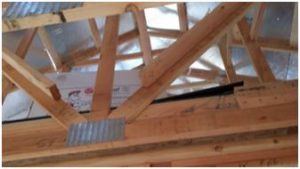Truss Plates for Column Uplift
The uplift of column in post frame (pole buildings) is a factor which is seemingly all too often overlooked in building design.
Several methods for resisting uplift forces are utilized. However the most popular option which historically has been used seems to be to pretend uplift doesn’t exist! Sadly, the most frequent method of constructing pole buildings is to backfill around the treated columns with the soil which came out of the hole, and call it a day.
Research has shown, encasement of some or the entire column in concrete to be the only reliable method of preventing uplift.
In some cases, attempts have been made to control uplift forces by the attachment of pressure preservative treated “cleats” at the bottom of the columns. Provided the fasteners used to attach the cleats are adequate, and the soil above them is adequately compacted, this method might prove to be a viable, although time consuming solution.
 A Florida company has come up with an interesting adaptation of the steel truss plates commonly used to pre-fabricate roof trusses. I have yet to see any research as to the effectiveness of the design, but my years in the truss industry caused this option to perk my interest.
A Florida company has come up with an interesting adaptation of the steel truss plates commonly used to pre-fabricate roof trusses. I have yet to see any research as to the effectiveness of the design, but my years in the truss industry caused this option to perk my interest.
The company has introduced a time-saving adaption in truss plate technology with its new Up-Lift Plates.
These inexpensive plates are field applied, with just a framing hammer, eliminating extra tools and time associated with using rebar or other uplift techniques. The end result is less time and money for post-frame builders, while exceeding post uplift requirements.
As yet, I’ve been unable to locate a website for the manufacturer, and I’ve not been able to find any UCC (Uniform Construction Code) approval numbers for the product. Be assured, when the information is available, I’ll be writing more about it.






